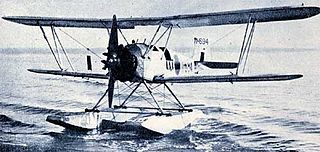| H-2 | |
|---|---|
 | |
| Standard H-3 | |
| Role | Trainer |
| National origin | United States |
| Manufacturer | Standard Aircraft Corporation |
The Standard H-2 was an early American Army reconnaissance aircraft, ordered in 1916. The H-2 was built by the Standard Aircraft Corporation, and previously known as the Sloane H-2. It was an open-cockpit three-place tractor biplane, powered by a 125 hp (90 kW) Hall-Scott A-5 engine. Only three were built.

The United States of America (USA), commonly known as the United States or America, is a country composed of 50 states, a federal district, five major self-governing territories, and various possessions. At 3.8 million square miles, the United States is the world's third or fourth largest country by total area and is slightly smaller than the entire continent of Europe's 3.9 million square miles. With a population of over 327 million people, the U.S. is the third most populous country. The capital is Washington, D.C., and the largest city by population is New York. Forty-eight states and the capital's federal district are contiguous in North America between Canada and Mexico. The State of Alaska is in the northwest corner of North America, bordered by Canada to the east and across the Bering Strait from Russia to the west. The State of Hawaii is an archipelago in the mid-Pacific Ocean. The U.S. territories are scattered about the Pacific Ocean and the Caribbean Sea, stretching across nine official time zones. The extremely diverse geography, climate, and wildlife of the United States make it one of the world's 17 megadiverse countries.

The United States Army Air Corps (USAAC) was the aerial warfare service of the United States of America between 1926 and 1941. After World War I, as early aviation became an increasingly important part of modern warfare, a philosophical rift developed between more traditional ground-based army personnel and those who felt that aircraft were being underutilized and that air operations were being stifled for political reasons unrelated to their effectiveness. The USAAC was renamed from the earlier United States Army Air Service on 2 July 1926, and was part of the larger United States Army. The Air Corps became the United States Army Air Forces (USAAF) on 20 June 1941, giving it greater autonomy from the Army's middle-level command structure. During World War II, although not an administrative echelon, the Air Corps (AC) remained as one of the combat arms of the Army until 1947, when it was legally abolished by legislation establishing the Department of the Air Force.

A reconnaissance aircraft is a military surveillance aircraft designed or adapted to perform aerial reconnaissance. Their roles include collection of imagery intelligence, signals intelligence, and measurement and signature intelligence. In addition to general intelligence gathering, modern technology has also enabled some aircraft and UAVs to carry out real-time surveillance.
Contents
An improved version, the H-3, with the same engine, earned an order for nine aircraft, while the Navy ordered three with floats as the H-4H.

The United States Navy (USN) is the naval warfare service branch of the United States Armed Forces and one of the seven uniformed services of the United States. It is the largest and most capable navy in the world and it has been estimated that in terms of tonnage of its active battle fleet alone, it is larger than the next 13 navies combined, which includes 11 U.S. allies or partner nations. with the highest combined battle fleet tonnage and the world's largest aircraft carrier fleet, with eleven in service, and two new carriers under construction. With 319,421 personnel on active duty and 99,616 in the Ready Reserve, the Navy is the third largest of the service branches. It has 282 deployable combat vessels and more than 3,700 operational aircraft as of March 2018, making it the second largest and second most powerful air force in the world.
Floats are airtight hollow structures, similar to pressure vessels, designed to provide buoyancy in water. Their principal applications are in watercraft hulls and aircraft floats, floating pier and pontoon bridge construction, and marine engineering applications such as salvage.
Two Standard H-3s were sold by the US Army to Japan, where a further three were built by the Provisional Military Balloon Research Association (PMBRA) in 1917, powered by 150 hp (110 kW) Hall-Scott L-4 engines. They were used as trainers between May 1917 and March 1918, although they were considered dangerous. [1]














